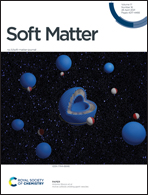Evaluating the effects of hydrophobic and cationic residues on antimicrobial peptide self-assembly
Abstract
Antimicrobial peptides typically contain hydrophobic and cationic residues, which allow them to interact with microbial cells and induce cell death. In a previous study, we found that the hydrophobic and cationic residues could also help antimicrobial peptides self-assemble into hydrogels, and this could be used as a novel approach for the preparation of hydrogel wound dressings. Therefore, in this work, four PAF26 peptide derivatives with different hydrophobic and cationic residues were used to study the effects of hydrophobic and cationic residues on self-assembly behaviours. It was found that all the PAF26 peptide derivatives could self-assemble into hydrogels, but the storage moduli, microscopic structures, secondary structure transformations, and antimicrobial abilities varied. In particular, peptides with a greater number of hydrophobic and cationic residues tended to undergo an unordered coil transformation and form bent nanofibers, while peptides with a lower number of hydrophobic and cationic residues tended to undergo β-sheet transformation and form straight nanofibers. In addition, antimicrobial experiments demonstrated that a strong crosslinked structure may have negative effects on the antimicrobial activity.



 Please wait while we load your content...
Please wait while we load your content...